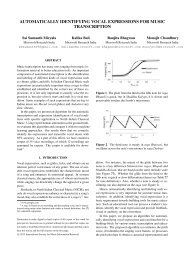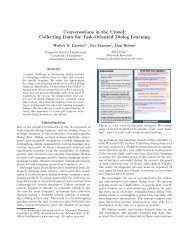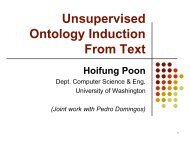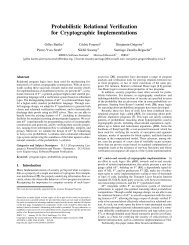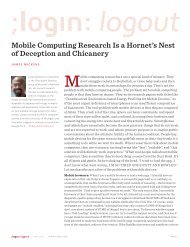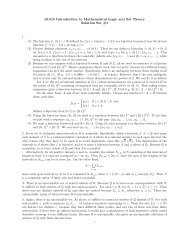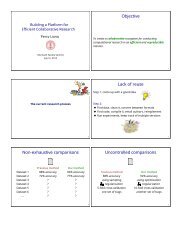On Intuitionistic Linear Logic - Microsoft Research
On Intuitionistic Linear Logic - Microsoft Research
On Intuitionistic Linear Logic - Microsoft Research
Create successful ePaper yourself
Turn your PDF publications into a flip-book with our unique Google optimized e-Paper software.
§2. Overview of <strong>Logic</strong>al Systems and The Curry-Howard Correspondence 3<br />
[A x ]<br />
·<br />
M: B<br />
(⊃I)x.<br />
λx: A.M: A ⊃ B<br />
It is common to annotate assumption packets with alphabetic identifiers rather than natural numbers.<br />
Thus we have a system for term formation, where the terms have the property that they<br />
uniquely encode the deduction.<br />
Although natural deduction has many compelling qualities, it has several disadvantages of which<br />
we shall mention just two (Girard [34, Page 74] gives a fuller criticism). Firstly it is distinctly<br />
asymmetric; there is always a single deduction from a number of assumptions. 1 Secondly, some<br />
connectives can only be formulated in an unsatisfactory way. Consider the rule for eliminating a<br />
disjunction<br />
·<br />
A ∨ B<br />
C<br />
[A x ]<br />
·<br />
C<br />
[B y ]<br />
·<br />
C (∨E)x,y.<br />
The deduction C really has nothing to do with the connective being eliminated at all: it is often<br />
dubbed parasitic.<br />
The second system we consider is the sequent calculus, again introduced by Gentzen [73]. Deductions<br />
consist of trees of sequents of the form Γ − ∆, where both Γ and ∆ represent collections<br />
of propositions. Inference rules introduce connectives on the right and on the left of the ‘turnstile’<br />
and rules have a more symmetric feel to them. For example the rules for introducing an implication<br />
are<br />
Γ − A, ∆ B, Γ ′ − ∆ ′<br />
Γ, A ⊃ B, Γ ′ − ∆, ∆ ′<br />
(⊃L), and<br />
Γ, A − ∆, B (⊃R).<br />
Γ − A ⊃ B, ∆<br />
In this thesis we will be concerned only with intuitionistic logics. These can be obtained by restricting<br />
the sequents to at most a single proposition on the right of the turnstile, Γ − A. There<br />
are other, less restrictive ways of formulating intuitionistic logics but we shall not consider them<br />
here. (For example, Hyland and de Paiva [43] have proposed a less restrictive (but more powerful)<br />
formulation of ILL.)<br />
Let us consider the form of Γ in a sequent Γ − A. We have a choice as to whether it represents<br />
a set, multiset or sequence of propositions. Recall that in the natural deduction system, we had<br />
multisets of assumptions, which could be empty. As the sequent calculus is an equivalent logical<br />
system it must offer similar manipulations of its assumptions. These manipulations are provided by<br />
so-called structural rules. 2 The structural rules needed depends on the chosen form of contexts and<br />
on the way the inference rules are devised (as they can have the effect of structural rules ‘built-in’).<br />
Generally we take the contexts to be multisets and then we have two structural rules 3<br />
Γ − B Weakening, and<br />
Γ, A − B<br />
Γ, A, A − B Contraction.<br />
Γ, A − B<br />
1 A number of multiple conclusion formulations of natural deduction have been proposed, but they invariably<br />
introduce more problems than they solve.<br />
2 These rules really exist in the natural deduction formulation as well but they are often either embedded in informal<br />
conditions concerning the assumption packets or built into the inference rules.<br />
3 Were we interested in the order in which assumptions were used, then we would take contexts to be sequences of<br />
assumptions and have an explicit Exchange rule:<br />
Γ, A, B − C<br />
Exchange<br />
Γ, B, A − C



